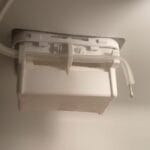Have you ever faced the frustration of a deadbolt stuck in a locked position? It’s more than just an inconvenience—it can make you feel trapped and powerless right in your own home.
If you’re staring at a door that won’t budge, you’re probably wondering what’s causing the problem and how to fix it quickly. Don’t worry, you’re not alone, and there are simple steps you can take to get your deadbolt working smoothly again.
Keep reading, and you’ll discover practical tips that save you time, stress, and even costly locksmith bills.
Common Causes Of A Stuck Deadbolt
A deadbolt stuck in a locked position can be frustrating and worrying. Understanding the common causes helps to fix the problem quickly. Several factors can cause a deadbolt to jam or stop working smoothly. Identifying these issues makes it easier to decide what to do next.
Weather And Temperature Effects
Extreme weather often affects deadbolts. Cold weather can cause metal parts to shrink and stick. Heat may expand parts, making the lock tight. Moisture from rain or snow can cause rust and freezing. These changes make the deadbolt hard to move or stuck.
Misalignment Issues
Doors and frames can shift over time. This movement causes the deadbolt to miss the strike plate. When parts do not line up, the bolt cannot slide in or out easily. Misalignment often leads to a stuck deadbolt or difficulty turning the key.
Wear And Tear
Deadbolts wear down with daily use. Springs inside can weaken or break. Metal parts may become loose or bent. Old locks may fail due to constant pressure and motion. Wear and tear cause the deadbolt to stick or jam.
Debris And Dirt Build-up
Dirt, dust, and small debris can enter the lock. These particles block the mechanism inside the deadbolt. Over time, build-up makes turning the key tough. Cleaning the lock regularly helps prevent this problem and keeps it working smoothly.

Credit: www.reddit.com
Tools Needed For Quick Fixes
Fixing a deadbolt stuck in a locked position needs the right tools. Having these tools ready saves time and frustration. Most quick fixes require only a few common items found at home or in a local store.
Basic Household Tools
Start with simple tools like a screwdriver. Both flathead and Phillips types can help remove the lock cover. A small hammer can gently tap parts loose if stuck. Needle-nose pliers help grip and turn small pieces inside the lock. Keep a flashlight nearby to see inside tight spaces clearly.
Lubricants And Cleaning Supplies
Lubricants are key to freeing a stuck deadbolt. Use graphite powder or silicone spray for smooth movement. Avoid oil-based lubricants that attract dust and dirt. Cleaning supplies like a soft cloth and cotton swabs remove grime. A can of compressed air can blow out dust from inside the lock mechanism.
Step-by-step Quick Fixes
A deadbolt stuck in the locked position can cause stress and delay. Quick fixes can often solve this problem without calling a locksmith. Follow these easy steps to get your deadbolt working smoothly again.
Lubricate The Deadbolt
Start by applying a lubricant to the deadbolt. Use graphite powder or a silicone-based spray. Avoid oil-based lubricants as they can attract dirt. Spray the lubricant into the keyhole and on the bolt itself. Work the key in and out several times to spread the lubricant.
Check And Adjust Alignment
Check if the bolt and strike plate line up properly. Misalignment can cause the deadbolt to stick. Close the door slowly and see where the bolt hits the frame. Loosen the screws on the strike plate and move it slightly. Tighten the screws and test the lock again.
Clean The Lock Mechanism
Dirt and debris can block the lock’s inner parts. Use compressed air to blow out dust from the keyhole. Wipe the surface with a clean cloth. Avoid using water or harsh chemicals. Cleaning helps the deadbolt move smoothly.
Tap And Gently Wiggle The Bolt
Sometimes the bolt may be stuck inside the door. Tap it gently with a small hammer or handle. While tapping, try to turn the key slowly. Wiggle the bolt back and forth lightly. This can free up any stuck parts inside the lock.

Credit: www.youtube.com
When To Call A Locksmith
Knowing when to call a locksmith is key if your deadbolt is stuck in a locked position. A stuck deadbolt can cause stress and limit access to your home. Acting early can prevent bigger problems. Recognizing the right signs helps you decide when professional help is needed.
Signs Of Internal Damage
Listen for grinding or unusual sounds when turning the key. The deadbolt may feel loose or jammed without smooth movement. Keys might get stuck or break inside the lock. Visible rust or corrosion can also indicate internal damage. These signs show the lock needs expert repair.
Avoiding Further Damage
Do not force the key or deadbolt to move. Forcing can break parts inside, making repairs costly. Avoid using oil or sprays unless a locksmith recommends them. Keep the door and lock area clean from dirt and dust. Calling a locksmith early saves time and money on repairs.
Preventing Future Deadbolt Issues
Deadbolt problems can cause big headaches. Preventing future deadbolt issues saves time and money. Small steps keep your lock working well. Regular care stops jams and breaks. Choosing the right deadbolt helps avoid troubles too.
Regular Maintenance Tips
Check your deadbolt every few months. Clean around the lock with a soft cloth. Remove dirt and dust that block moving parts. Use a graphite lubricant to keep it smooth. Avoid oil sprays that can attract grime. Test the lock by turning the key gently. Fix small problems before they grow bigger.
Choosing The Right Deadbolt
Pick a deadbolt made from strong materials like steel. Look for locks with good reviews and ratings. Choose one with a smooth locking mechanism. Consider the lock size that fits your door well. Buy from trusted brands with warranties. A good deadbolt lasts longer and works better. This reduces the chance of it getting stuck.

Credit: www.youtube.com
Frequently Asked Questions
Why Is My Deadbolt Stuck In The Locked Position?
A stuck deadbolt often means dirt, rust, or a broken internal part is blocking movement.
How Can I Fix A Deadbolt Stuck While Locked?
Try lubricating the lock with graphite or WD-40 and gently jiggle the key or thumb turn.
Can Temperature Changes Cause A Deadbolt To Get Stuck?
Yes, cold weather can cause metal parts to contract and jam the lock mechanism.
When Should I Call A Locksmith For A Stuck Deadbolt?
Call a locksmith if lubrication and simple fixes don’t work or if the key won’t turn at all.
How To Prevent A Deadbolt From Getting Stuck Again?
Regular cleaning and lubrication keep the lock smooth and prevent dirt buildup or rust.
Conclusion
A deadbolt stuck in a locked position can cause stress. Simple steps can often fix the problem quickly. Regular maintenance helps keep your lock working well. Don’t ignore small issues; they can get worse. Sometimes, you may need a professional locksmith’s help.
Acting fast protects your home’s security and your peace of mind. Keep your locks clean and lubricated to avoid trouble. Remember, a working deadbolt is key to safety. Stay calm and take action when needed.




